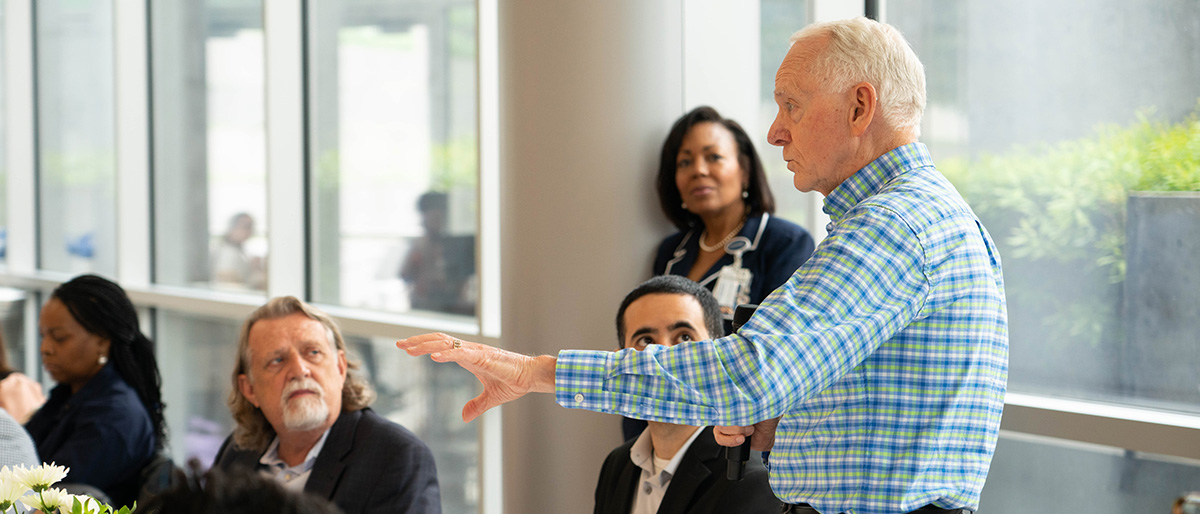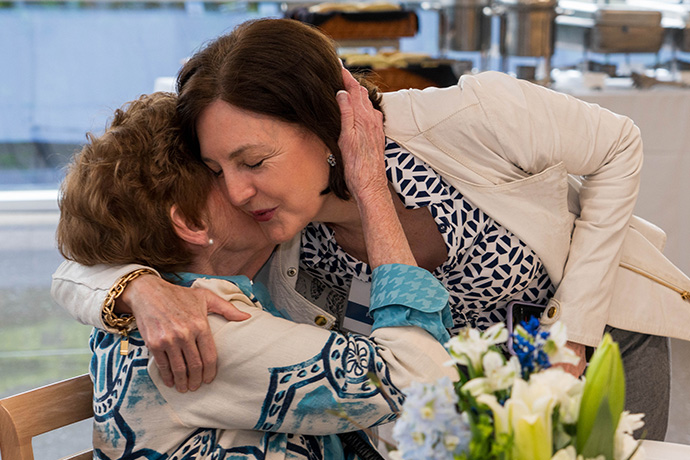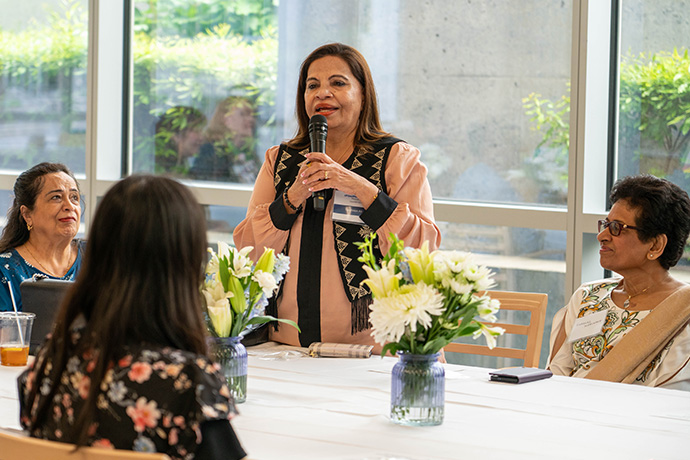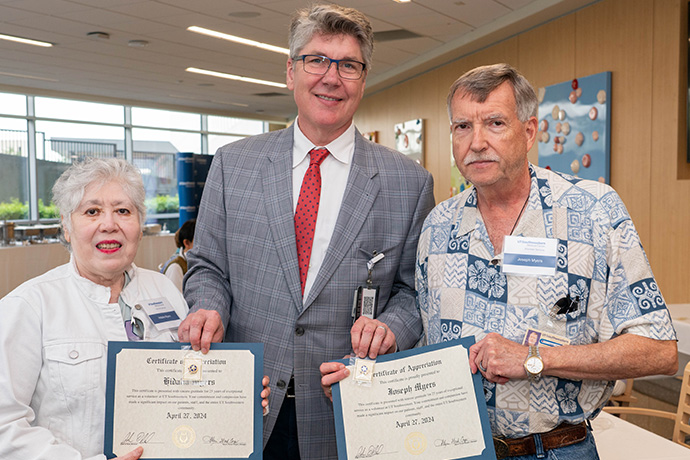Twice as many participants, twice as much gratitude
UT Southwestern program volunteers recognized at annual appreciation luncheon

During UT Southwestern’s annual Volunteer Appreciation Luncheon, there is always plenty to celebrate as longtime friends gather over a homestyle buffet meal, a tall glass of iced tea, and a delicious slice of cake.
But this time, going back for seconds was certainly in order – because both the number of volunteers on the roll and the amount of hours they served in 2023 more than doubled over the previous year.
“How important it is for us to take the time each year to let you know, in some small way, how much of a difference you make,” the Rev. John O’Neal, UTSW’s Director of Spiritual Care and Support and Volunteer Services, told the participants. “We give thanks for your hands that work and make this place what it is.”

He said there was no way to fully repay volunteers for the hours they spend supporting patients and caregivers – both emotionally and logistically. But he hoped taking the opportunity to personally say “thank you” was a good start.
About 50 volunteers attended the luncheon held Saturday, April 27, in the John and Ginny Eulich Pavilion at William P. Clements Jr. University Hospital (CUH) in recognition of Volunteer Week.
The program began in 1943 with the creation of the St. Paul Auxiliary, whose members made supplies for UTSW’s former St. Paul University Hospital. Today volunteers support patients at William P. Clements Jr. University Hospital, Zale Lipshy Pavilion, the Harold C. Simmons Comprehensive Cancer Center, UT Southwestern Monty and Tex Moncrief Medical Center at Forth Worth, UT Southwestern Medical Center at Frisco, and UT Southwestern Medical Center at RedBird, comforting them by talking and listening, reading, playing games or by bringing them a drink if they’re thirsty. They also assist by assembling packets and tackling administrative tasks such as answering phones and sorting mail, freeing up caregivers to focus on their work.
UTSW’s program currently has 1,027 volunteers, with 332 assigned on any given day. The Rev. O’Neal said it took some time to rebuild the volunteer program after the pandemic. But he was excited to report that participation is even higher now, as is the impressive total of 20,216 hours donated in 2023 versus 2022.
“It’s the best job I have ever had in my life. I get so much more from the patients than I give,” said volunteer Gary Billingsley.

He shared the story of one crying, lonely patient who confided in him that when she had to stay in the hospital for surgery, her family didn’t come to support her. The patient said his spending time with her made her spirit soar. Helping the woman gave Mr. Billingsley a sense of a higher purpose in life that still inspires him to this day. “I just want to thank you for the opportunity to be on the floor and meet so many people,” he said.
While many volunteers are retired seniors who have an abundance of free time and a desire to make a difference in their community, UT Southwestern has seen a groundswell of teenage volunteers as well.
Sherri Wood Cooper, Manager of Volunteer Services, said UTSW’s Summer Youth Program enlisted about 40 teenagers on voluntary assignments last summer. A slightly larger group is expected this year. The application period had to be cut short after just four days because 219 students had already applied for the available spots. Ms. Wood Cooper said the surge of interest will likely cause the program to expand next year.
Often the teen volunteers are future doctors, nurses, and techs interested in medical careers. But sometimes they form a bond as lifetime volunteers at UT Southwestern.
“You all take your time, talents, and energy to come here and be of service to not only the patients and their families, but to the staff as well at UTSW, and for that we are eternally grateful,” Ms. Wood Cooper told the luncheon attendees. “Our greatest commodity is time. Your volunteerism is so important to us and so heroic.”
The following volunteers were recognized for achieving service milestones:
- 500 hours: Alan Jacob and Berta Montes
- 1,000 hours: Victor “Aleck” Dwyer, Manish Samson, and Stephen Zavadsky
- 4,000 hours: Dolly Wu
- 6,500 hours: Todd Laylock
- 5 years: Sheryll Barker, Anat Fuksman, Diane Gossett, Sue Harvey, William Jefferson, Mary “Vicki” Moran, Rosemary “Rosy” Paris-Bennett, Roland Pedevilla, Sharon Pedevilla, Ruth “Starr” Peterson, Glen Sale, Melynda Sylvester, Dolly Wu, Stephen Zavadsky
- 25 years: Hidalia Myers and Joseph Myers

“We have enjoyed volunteering,” said Mrs. Myers, who noted she began volunteering at St. Paul in Chaplain Services with her husband, Joseph, a quarter century ago, delivering magazines to patients.
Mr. Myers added: “Like some others’ stories here today, I think we get back a lot more than what we give. We’re here to listen to people, to pray with people, and to hear their stories. And it means a lot to us to be able to do that.”

